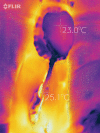Thermal Imaging in a Clinically Non-assessable Free Flap Reconstruction of the Face
- PMID: 33680684
- PMCID: PMC7929496
- DOI: 10.1097/GOX.0000000000003440
Thermal Imaging in a Clinically Non-assessable Free Flap Reconstruction of the Face
Abstract
Free flap monitoring and early detection of malperfusion are a central aspect in reconstructive surgery. Warm ischemia, measured as the time a certain tissue is able to survive without any additional medical or thermal treatment, ranges from hours in muscle and nerval tissue up to days in bony tissue. Hence, meticulous flap monitoring is essential to discover early signs of malperfusion and decide upon timely re-intervention. Besides clinical examination techniques and Doppler sonography, a multitude of mostly experimental procedures are available to evaluate free flap perfusion. Particularly in older patients, the assessment of the skin island in microvascular grafts is a demanding task because the natural loss of elasticity, the reduction of subcutaneous tissue, and the decrease in water content limit the visibility of capillary filling and favor hematomas. We report a case of a 90-year-old woman with an extensive cutaneous squamous cell carcinoma of the right zygomatic and lateral orbital region without any locoregional or distant metastasis. Due to the resilient health status, we decided for a surgical approach with consecutive microvascular radial forearm flap reconstruction. On account of the difficult assessment of elderly skin after microvascular transplantation, we decided on additional flap monitoring by thermal heat imaging during the operation and aftercare. This case report discusses the successful application of thermal heat imaging in a clinical non-assessable free flap and discusses the application of dynamic infrared thermography as a monitoring tool in microvascular free flap surgery.
Copyright © 2021 The Authors. Published by Wolters Kluwer Health, Inc. on behalf of The American Society of Plastic Surgeons.
Figures




Similar articles
-
New perspective on the in vivo use of cold stress dynamic thermography in integumental reconstruction with the use of skin-muscle flaps.J Surg Res. 2017 May 15;212:68-76. doi: 10.1016/j.jss.2016.12.022. Epub 2016 Dec 29. J Surg Res. 2017. PMID: 28550924 Clinical Trial.
-
Robot-assisted Sistrunk's operation, total thyroidectomy, and neck dissection via a transaxillary and retroauricular (TARA) approach in papillary carcinoma arising in thyroglossal duct cyst and thyroid gland.Ann Surg Oncol. 2012 Dec;19(13):4259-61. doi: 10.1245/s10434-012-2674-y. Epub 2012 Oct 16. Ann Surg Oncol. 2012. PMID: 23070784
-
Use of a monitor muscle flap in buried free forearm flap transfer.Ann Plast Surg. 1996 Oct;37(4):364-6. doi: 10.1097/00000637-199610000-00004. Ann Plast Surg. 1996. PMID: 8905043
-
Dynamic InfraRed Thermography (DIRT) in DIEP-flap breast reconstruction: A review of the literature.Eur J Obstet Gynecol Reprod Biol. 2019 Nov;242:47-55. doi: 10.1016/j.ejogrb.2019.08.008. Epub 2019 Aug 23. Eur J Obstet Gynecol Reprod Biol. 2019. PMID: 31563818 Review.
-
Functional reconstruction of subtotal glossectomy defects with radial forearm free flap: case report and review of literature.Folia Med (Plovdiv). 2012 Apr-Jun;54(2):60-5. doi: 10.2478/v10153-011-0090-x. Folia Med (Plovdiv). 2012. PMID: 23101287 Review.
Cited by
-
Postoperative free flap monitoring in reconstructive surgery-man or machine?Front Surg. 2023 Feb 22;10:1130566. doi: 10.3389/fsurg.2023.1130566. eCollection 2023. Front Surg. 2023. PMID: 36911625 Free PMC article. Review.
-
Macrophage Migration Inhibitory Factor-An Innovative Indicator for Free Flap Ischemia after Microsurgical Reconstruction.Healthcare (Basel). 2021 May 21;9(6):616. doi: 10.3390/healthcare9060616. Healthcare (Basel). 2021. PMID: 34063809 Free PMC article.
References
-
- Nakatsuka T, Harii K, Asato H, et al. . Analytic review of 2372 free flap transfers for head and neck reconstruction following cancer resection. J Reconstr Microsurg. 2003;19:363–368. - PubMed
-
- Wolff KD, Hölzle F, Wysluch A, et al. . Incidence and time of intraoperative vascular complications in head and neck microsurgery. Microsurgery. 2008;28:143–146. - PubMed
-
- Blaisdell FW. The pathophysiology of skeletal muscle ischemia and the reperfusion syndrome: A review. Cardiovasc Surg. 2002;10:620–630. - PubMed
Publication types
LinkOut - more resources
Full Text Sources
Other Literature Sources
